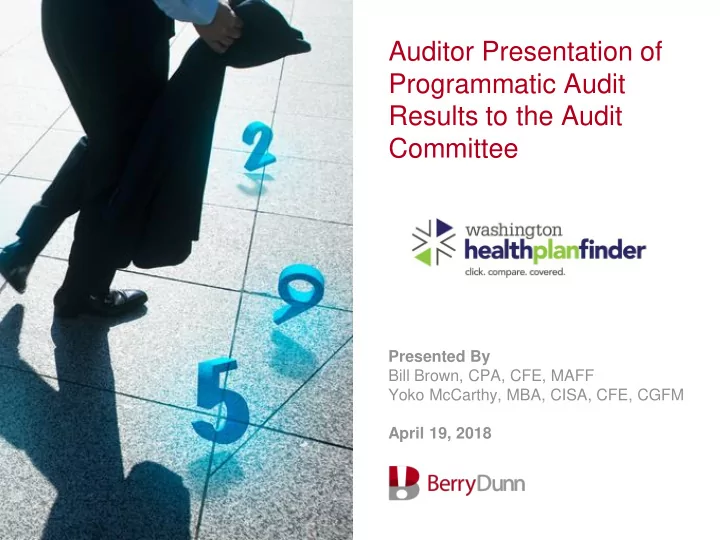

Auditor Presentation of Programmatic Audit Results to the Audit Committee Presented By Bill Brown, CPA, CFE, MAFF Yoko McCarthy, MBA, CISA, CFE, CGFM April 19, 2018
Agenda • Programmatic Audit Overview • Three Year Programmatic Audit Plan • Suggested Audit Procedures by CMS • Eligibility, Enrollment, and Verification Testing Highlights • CMS Findings Report Terminologies • Finding #2017-001 • Next Steps – Plan for FY18 Audit • Questions/Contact Us 2
Programmatic Audit Overview INDEPENDENT • State Based Marketplaces (SBMs) are required to engage an EXTERNAL AUDIT independent external or independent state-government auditing entity to conduct an external financial and programmatic audit. REQUIREMENT • The annual financial and programmatic independent external audit AUDIT STANDARDS should follow generally accepted governmental auditing standards (GAGAS). • By June 1, 2018, SBMs are required to submit documents or attest to the submission of documents for the following components of the DEADLINE AND State-Based Marketplace Annual Reporting Tool (SMART) : • SUBMISSION Eligibility and Enrollment • Financial and Programmatic Audit METHODS • Program Integrity • Attestation of Completion 3
Three Year Programmatic Audit Plan Audit Year 1 Audit Year 2 Audit Year 3 Subpart (18 mons from (12 mons from (12 mons from 7/1/16 – 6/30/17) 7/1/17 – 6/30/18) 1/1/15-6/30/16) B – General Standards Yes No No C – General Functions of an Exchange Yes Yes Yes D – Eligibility Yes Yes Yes E – Enrollment Yes Yes Yes F – Appeals of Eligibility Determinations Yes No No G – Exemptions No No No H – SHOP Yes No No K – QHP Certifications Yes Yes Yes M – Oversight Yes Yes Yes N – State Flexibility No No No O – Quality Reporting No No No* *Subpart O only includes two requirements: To display the Quality Rating information and the Enrollee Satisfaction Survey for each QHP on its website. These requirements are also included in Subpart C and will be covered during the FY18 audit.
Suggested Audit Procedures by CMS The independent external auditor can define its own methodology, as long as guidelines set for the in GAGAS are followed. The auditor should consider including the following procedures in its field work and associated test steps: Review of SBM policies and procedures Review of staff training materials Review of notices to consumers Randomly select and interview Marketplace staff members to determine understanding of Marketplace requirements Select a sample of eligibility files to validate proper processing Select a sample of enrollment files to validate proper processing Review/select a sample of completed QHP issuer applications for compliance with certification requirements 5
Eligibility, Enrollment, and Verification Testing Highlights • Entire population: 2,127,612 applicants who had an eligibility determination completed between July 1, 2016 and June 30, 2017. • We selected 95 cases to test for compliance with eligibility rules, which included both Apple Health and QHP applicants. • We selected 95 cases to test for compliance with enrollment rules, which include QHP applicants only . • Note that 21 of the cases were used for both eligibility and enrollment testing, so a total of 169 individual cases were used for testing compliance with enrollment and eligibility rules. • We selected 15 cases that were given conditionally eligible status during the audit period to test for compliance with data verification requirements.
CMS Findings Report Terminologies Criteria • The laws, regulations or other standards against which performance is compared or evaluated. They identify the required or desired state or expectation for the program or operation, and provide a context for evaluating evidence and understanding findings. Condition • The situation as it exists. Cause • Identifies the reason for the difference between the condition and the criteria, and may provide a basis for recommending corrective action. Effect • Identifies the outcomes or consequences of the condition. Recommendation • Our recommended corrective action. 7
Finding #2017-001 Condition • Of 15 cases BerryDunn reviewed, we discovered exceptions to the notification criteria for two of these applications. For one case, the notification to the applicant of the data inconsistency, and request to provide additional information to resolve the inconsistency, was not sent until four months after the original conditional eligibility was granted. In the other case, the original data inconsistency notification included an incorrect due date and an updated notification with the correct due date set at the 90th day from issuance was not sent until six months later. • Subsequent to the issuance of the previous examination report, WAHBE identified six defects in the system that were independently causing the issues described above. During the year ended June 30, 2017, WAHBE management indicated they resolved five out of the six identified defects, leaving one known defect that caused the system to leave the document due date field in income verification notices null. WAHBE management indicated they released the code fix for this defect in September 2017 and verified that the code fix passed post-validation testing in October 2017. Effect • The failure to issue appropriate notices of discrepancy may have resulted in WAHBE providing Advance Premium Tax Credit and Cost Sharing Reduction to applicants who were not eligible for the benefit during the audit period. Recommendation • WAHBE informed us that all the known system defects causing this condition have been addressed as of this report date. We recommend WAHBE continue monitoring and verification activities to ensure that notifications are sent in a timely manner. 8
Next Steps – Plan for FY18 Audit Planned field work schedule: • Financial Audit: Week of August 7, 2018 • Programmatic Audit: TBD Targeted Audit Report Due Dates: • Financial Audit: September 28, 2018 • Programmatic Audit: March 29, 2019 9
Contact Us BILL BROWN, CPA, CFE, MAFF Principal bbrown@berrydunn.com 207.541.2208 SARAH BELLIVEAU, CPA Principal sbelliveau@berrydunn.com 207.541.2237 YOKO MCCARTHY, MBA, CISA,CFE,CGFM Manager ymccarthy@berrydunn.com 207.541.2312 This communication is intended solely for the information and use of the Audit Committee and management and is not intended to be, and should not be, used by anyone other than these specified parties. 10
Recommend
More recommend